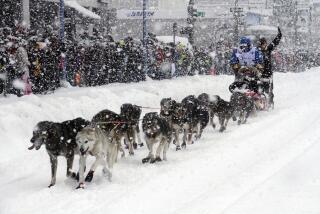Tough Sledding : Life Is Brutal, Often Cut Short for Eskimo Dogs
- Share via
BUTTON POINT, Canada — Its white coat and black bandit face marked it as a Siberian husky. It was a young dog, probably no more than a year old. But, sitting in the bitter cold on a small pressure ridge near the edge of an ice floe, it trembled like a palsied derelict.
“He’s just wasted,” said schoolteacher Carl Jorgensen, swinging his arms to keep warm. “He’s lost and tired and scared. Just wasted.”
Jorgensen and his friend Robert Swann, a social worker with frostbite scabs on his face, fed the animal a half-tin of corned beef.
“He probably got loose from some guy’s dog team,” said Jorgensen, who teaches at the Eskimo school in Pond Inlet, 43 miles across the frozen, treeless wilderness. “He’ll never make it back to town on his own.”
Soon two Eskimo hunters arrived on a snowmobile pulling a sled large enough to carry the dog. Jorgensen and Swann roared off on their snowmobiles. After a brief discussion, the hunters left too--without the animal. “He’ll find his way back,” one of the hunters assured a visitor.
The rough life of sled dogs in the eastern Arctic concerns many of the non-Eskimo Canadians in the northern communities--and presents them with a conundrum. Many, including law-enforcement and humane-society officials, say they are reluctant to interfere with treatment they consider brutal.
“What somebody does with their dogs is generally considered their business up here,” said Scott Bringloe, another teacher at the Pond Inlet school and the only non-native dog-team owner in the community of 1,050. Bringloe uses his dogs mostly to take his family and friends out for sled rides.
Eskimos use dog teams primarily to take out tourists, often for sport hunting of polar bears.
Wildlife authorities say that only a tiny minority of Eskimos use dogs for subsistence hunting. Snowmobiles, though more expensive to buy and operate, are far more efficient.
“In the old days, I’m sure the dogs were better treated because they relied on them more for survival,” said Mitch Taylor, a government wildlife biologist. “Now there’s guaranteed food, fuel, health care. A lot of people have lost the more traditional, caring attitude toward their dogs.”
Treatment of sled dogs varies. But troublesome animals are commonly beaten, shot or abandoned far from home--the equivalent of a death sentence in the vast, empty North.
Bringloe tells of recently watching in horror as an Eskimo owner tied a husky to the back of his snowmobile with a 6-foot rope and dragged the dog over more than 200 yards of rough ice at top speed, about 25 m.p.h.
“Apparently this dog had done something wrong or wasn’t running up to snuff,” Bringloe said. “The dog was hitting the high points on the ice, and that was about it.”
The owner then unhooked the dog and ran over it with the 500-pound machine. The battered animal crawled under a snow bank, where it could not be reached, and later died.
Although Bringloe reported the incident to local authorities, no action was taken against the owner.
Not all dogs are treated so cruelly in the eastern Arctic. But even at best, their lives are typically cold, hard and, by non-Eskimo standards, brutal.
Working sled-dog teams spend most of their lives, including entire winters, staked on ice at the ends of short chains. They endure gale-force winds and temperatures as low as minus 75 degrees Fahrenheit. Food is often scarce, and they consume snow in place of fresh water.
There are no veterinarians in the communities to care for sled dogs when they are sick or injured. They are kicked and whipped when they get into fights or otherwise annoy their owners.
One of their few true joys seems to be pulling sleds, as they have for hundreds of years. But when they get too old to pull, they usually are shot.
Abusive treatment of dogs “has been a way of life for years, and it’s become the norm,” said Brian Wentzell, a Royal Canadian Mounted Police constable in Pond Inlet.
But many people, like Michael O’Sullivan of the Toronto-based World Society for the Protection of Animals, want to see it become the exception.
He said: “When somebody kicks a dog so hard that it breaks its ribs, and then says, ‘Well, we’ve always done it that way,’ I don’t regard that as an acceptable answer.”
More to Read
Sign up for Essential California
The most important California stories and recommendations in your inbox every morning.
You may occasionally receive promotional content from the Los Angeles Times.











